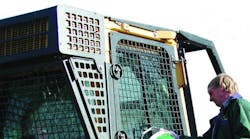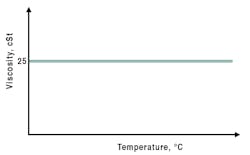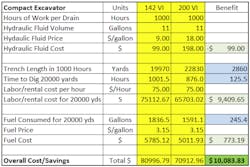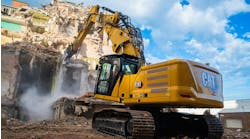This file type includes high resolution graphics and schematics when applicable.
In a case study published in the December 2009 issue of Hydraulics & Pneumatics, a new hydraulic excavator was shipped to site filled with the wrong type of hydraulic oil. The consequence of this mistake was four main pump failures—at a cost of $20,000 each, three swing motor failures, and two track drive motor failures—all within the first 27 months of operation. In fact, the total cost of failures, including downtime, amounted to $193,872 over the first two 27 months of this machine’s life.
Although the hydraulic equipment you’re responsible for may not be on the same scale, the principle is the same: If the hydraulic system is not filled with the right type and grade of oil, it won’t perform like it should, and it won’t last like it should.
Why Hydraulic Fluid is Different from Other Lubricants
Hydraulic fluid is different from other oils. Not only is it a lubricant, it’s also the means by which power is transferred throughout the hydraulic system. So it’s a lubricant and a power transmission device. This dual role makes it unique.
To be an effective and reliable lubricant, hydraulic oil must possess properties similar to most other lubes. These include foaming resistance and air release; thermal, oxidative, and hydrolytic stability; anti-wear performance; filterability; demulsibility; rust and corrosion inhibition; and viscosity in respect to its influence on lubricating film thickness—which is critical for maximum service life of hydraulic components.
To be most efficient in its role as a power transmission device, hydraulic oil needs high bulk modulus (high resistance to reduction in volume under pressure) and high viscosity index (low rate of change in viscosity with temperature).
As an analogy, consider a V-belt drive. If its tension is out of adjustment, the belt will slip. The result is a higher percentage of input power wasted to heat. This means less power is available at the output to do useful work. In other words, the drive becomes less efficient. A similar situation can occur with hydraulic oil. Change in its bulk modulus or viscosity can affect the efficiency with which power is transmitted in the hydraulic system.
The perfect hydraulic fluid for transmission of power would be infinitely stiff (incompressible) and have a constant viscosity of around 25 cSt, regardless of temperature. Unfortunately, such a fluid does not exist.
The Benefits of Multigrade Fluid
Bulk modulus is an inherent property of the base oil and can’t be improved with additives. But viscosity index (VI) can be improved by using high VI base stocks—such as synthetics—or by adding polymers called viscosity index improvers to the formulation.
Viscosity index improvers were first used to make multigrade engine oils in the 1940s. These days, this common and well-tested technology is used to make high VI (multigrade) oils for other applications, including automatic transmission fluids and manual transmission gear oils. However, the VI improvers used in oils for these applications are not typically shear stable when used in modern hydraulic systems. However recent advances in VI improver technology means that mineral hydraulic oils with a shear stable viscosity index in the 150 to 200 range are now commercially available. (Monograde, mineral hydraulic oils have a typical VI of between 90 and 100.)
The most common reason for using a multigrade hydraulic oil is to maintain viscosity within acceptable limits across a wide range of temperatures between winter and summer, thereby eliminating the need for seasonal oil changes. However, there is another case for considering the use of a multigrade hydraulic oil. Within the allowable extremes of viscosity required to maintain adequate film thickness for lubricating hydraulic components, there’s a narrower viscosity range where power losses are minimized Therefore, power transfer is maximized. By maintaining the oil’s viscosity in this optimum range, machine cycle times are faster (productivity is increased) and power consumption (fuel or electricity) is reduced.
So using a high VI or multigrade oil means the hydraulic system will remain in its power transmission “sweet spot” across a wider operating temperature range. You could think of this as similar to installing an automatic-tensioner on the V-belt drive mentioned earlier to maintain optimum power transfer conditions.
However, based on simple cost/benefit analysis, if the cost to install the tensioner was $200, this money should not be spent unless we’re satisfied this investment can be recovered—plus an acceptable return—through savings attributable to more efficient power transmission or reduced maintenance costs.
Shear stable, multigrade hydraulic oil is more expensive than monograde, so the same analysis should be applied when evaluating the cost and benefits of using a high VI hydraulic oil. But unlike the relatively simple V-belt drive, savings accruing from increased hydraulic machine performance can be more difficult to quantify.
This file type includes high resolution graphics and schematics when applicable.
Understanding the Benefits
This file type includes high resolution graphics and schematics when applicable.
To illustrate the economic benefits possible, consider the following results from a field trial conducted by a manufacturer of shear-stable VI improvers. The performance of a 40-hp compact excavator was evaluated using an all-season, 142 VI multigrade baseline oil and compared to that of the same machine using a 200 VI test oil. The test procedure was as follows:
1. Start with 142-VI oil, new air filter, fuel filter.
2. Top off fuel to fill neck at start of test.
3. Use trenching blade width to normal depth.
4. Dig trench for seven hours.
5. After seven hours, record fuel to refill.
6. Measure trench width, depth, and length.
7. Repeat steps 2-6 with second operator.
8. After baseline established, change hydraulic oil and filter, run for two hours and repeat oil and filter change with 200 VI oil. (Due to some dilution of the 200 VI oil with the 142 VI baseline oil after changeover, the actual VI of the test oil was less than 200.)
9. Repeat steps 2-7.
The higher VI test oil demonstrated the following advantages over the baseline oil:
- 15.4% improvement in fuel economy—that is, cubic yards of dirt moved per gallon of fuel consumed.
- 14.3% improvement in productivity—that is, cubic yards of dirt moved per hour.
To assign a value to these performance gains, a spreadsheet was developed to calculate an owner’s variable costs over the 1000 hour drain interval recommended by the excavator manufacturer. The following assumptions were made:
- All seasons baseline oil cost $9/gal and the 200 VI test oil cost $18/gal.
- Labor and equipment rental cost of $75/hr.
- Diesel fuel cost of $3.15/gal.
By extrapolating the results of the trial, it was determined that with the baseline oil, the excavator could dig approximately 20,000 yards of trench in 1000 hours. The same size trench could be dug in only 874 hours with the 200 VI test oil. No value was assigned to the additional 126 hr the machine owner could have to used to perform more work with the machine.
Based on the field test results and the assumptions stated above, replacing the 142 VI all seasons oil with 200 VI oil would save the machine owner $10,000 every 1000-hr drain interval. And note that while the fuel cost savings are meaningful, the greatest potential benefit from switching to higher VI oil is likely to accrue from machine productivity improvement.
As the results of this trial show, the potential economic gain from using a high VI or multigrade oil go beyond the simple elimination of seasonal oil changes to maintain operating viscosity within allowable limits. But the ultimate decision on whether to use a multigrade over a monograde involves weighing cost against benefit, the type of hydraulic machine, its duty cycle, and its temperature operating window.
The Problem with Multigrade Engine Oil
Engine oil can work satisfactorily as a hydraulic fluid. However, if a multigrade engine oil is being used in the hydraulic system specifically for its high viscosity index (VI), then it’s not the correct solution. The reason is the additives used to improve viscosity index.
Viscosity index improvers are relatively large molecules, which are curled into little balls at low temperatures and don’t thicken the oil. At higher temperatures, they uncurl into long chain molecules, which give the oil greater viscosity. The earliest VI improvers used to make multigrade engine oils in the 1940s were basically melted rubber. And this worked well in engine oil.
VI improver technology has advanced a lot since then. But even today, because they are long and complex molecules, they are susceptible to “shear down” as the oil circulates. Hydraulic systems typically produce shearing forces that break the long molecules of these VI improvers, rendering them ineffective at maintaining a stable viscosity at higher temperatures. And in terms of shearing forces, a modern hydraulic system is one of the most challenging there is for VI improvers.
Because VI improvers are an expensive additive, oil blenders formulate for the application. So while it would be possible to formulate a multigrade engine oil which would be shear stable when used in a hydraulic system, it would be overkill for the engine application and, therefore, add unnecessary extra cost. As a result, VI improved engine oils, automatic transmission fluids, and manual transmission gear oils typically are not shear stable when used in modern hydraulic systems. This means if they are used as a hydraulic fluid, the VI improvers will shear down over time and lose their ability to provide the necessary viscosity improvement, which defeats the purpose of using them in the first place.
So if the temperature operating window of your hydraulic equipment dictates the use of a multigrade oil, or you seek the productivity advantages described here, engine oil is not usually the best choice. A multigrade oil formulated specifically for hydraulic systems should be used instead.
Brendan Casey is the founder of HydraulicSupermarket.com and the author of Insider Secrets to Hydraulics, Preventing Hydraulic Failures, The Hydraulic Troubleshooting Handbook, Hydraulics Made Easy, Advanced Hydraulic Control, and The Definitive Guide to Hydraulic Troubleshooting. A hydraulics specialist with an MBA, he has more than 25 years experience in the design, maintenance, and repair of mobile and industrial hydraulic equipment. For more information, visit his website or read his blog on our website.
This file type includes high resolution graphics and schematics when applicable.
Learn More about Hydraulics
This file type includes high resolution graphics and schematics when applicable.





